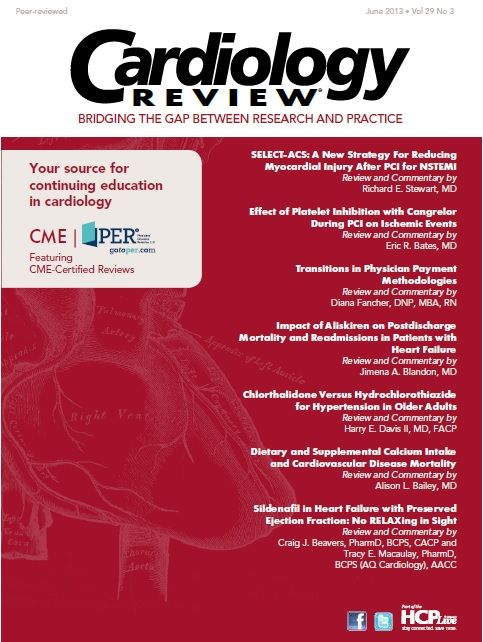Publication
Article
Cardiology Review® Online
Summer Reading
Debabrata Mukherjee, MD, MS, FACC
Editor-in-Chief
The hot summer days are upon us and in this issue of Cardiology Review we cover several burning topics of interest to clinicians. Dr. Jimena Blandon discusses the impact of aliskiren on postdischarge mortality and readmissions in patients with heart failure. The study showed that there was an increase in the adverse effects in the aliskiren subgroup, especially with respect to renal failure, hypotension, and other symptoms. She opines that it would be interesting to know if the combination of aliskiren with either an angiotensin-converting enzyme inhibitor (ACEI) or angiotensin receptor blocker (ARB) or with an aldosterone inhibitor (dual therapy) would be better than “triple therapy” combining aliskiren plus ACEI/ARB plus an aldosterone inhibitor with respect to the incidence of hyperkalemia. Additional studies are needed to provide more data on aliskiren’s effects in patients with and without heart failure and type 2 diabetes.
Drs. Craig Beavers and Tracy Macaulay review the role of sildenafil in heart failure with preserved ejection fraction. They conclude that the lack of benefit with inhibition of PDE-5 in heart failure with preserved ejection fraction adds to a growing list of failed pharmacotherapy efforts in the management of this syndrome. It appears that for now, care for patients with heart failure with preserved ejection fraction should continue to focus on strategies that reduce symptoms of this syndrome, including loop diuretics and stringent control of comorbidities, such as hypertension, diabetes, and atrial fibrillation. Dr. Harry Davis discusses chlorthalidone versus hydrochlorothiazide for hypertension in older adults. He concludes that while this study has emphasized the risk of potassium loss with thiazide diuretics, it also raises the question as to the potential for improved cardiovascular outcomes with chlorthalidone if more conservative dosing were coupled with potassium-conserving measures. Thus, for now, the choice of chlorthalidone over hydrochlorothiazide may still be clinically reasonable.
Dr. Diana Fancher discusses a very hot topic — transitions in physician payment methodologies. She points out that bundling of hospital, physician, and provider payments will be a complete change in how health care is provided. The intent to improve quality, coordinate care, and decrease costs is noble, but will serve to create new chasms of difficulty during this realignment and change in perceptions, behavior, and expectations.
Dr. Eric Bates reviews the effect of platelet inhibition with cangrelor during percutaneous coronary intervention (PCI) on ischemic events and suggests that if cangrelor is approved for clinical use, it may have to compete against the strategy of unfractionated heparin and bolus-only GP IIb/ IIIa inhibitor therapy (wholesale cost, approximately $330). A strategy of bivalirudin plus cangrelor would probably be cost prohibitive.
Dr. Richard Stewart reflects on the SELECTACS study and states that data from this early study suggests that inclacumab, acting as an antagonist to P-selectin, reduces myocardial damage and injury after PCI in NSTEMI patients. Further investigation will be needed to focus on the benefits and risk profile of inclacumab in patient subsets, including people with diabetes, elderly patients, and patients not undergoing PCI.
Dr. Alison Bailey looks at dietary and supplemental calcium intake and cardiovascular disease mortality and concludes that until randomized, controlled trial data exist or more mechanistic data are available, caution should be used with calcium supplementation. A diet that is high in calcium-rich foods, such as low-fat dairy products, beans, leafy green vegetables, certain fruits, and nuts, is a viable way to obtain recommended calcium levels and has the added benefit of being part of a heart healthy lifestyle.
Finally, in our Clinician’s Forum section, Drs. Carol Chen, Rabab Mohsin, and Karla Quevedo engage in a very lively conversation on the effects of the 2011 versus 2003 duty hour regulations. Ms. Jackie Syrop (our excellent managing editor) has put together a succinct summary of several key clinical trials presented at the American Society of Hypertension meeting, which I am sure you will find useful reading.
I hope that you will find these commentaries to be valuable and enjoyable. I encourage you to share your insights, thoughts, and personal experiences on the topics touched upon in this issue. On a broader level, I would love to hear feedback on how we can make this journal even better. My goal continues to be to make you look forward to every issue of Cardiology Review.
Debabrata Mukherjee
Editor-in-Chief






